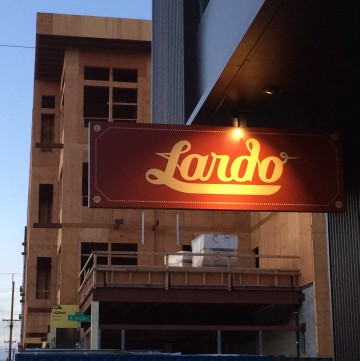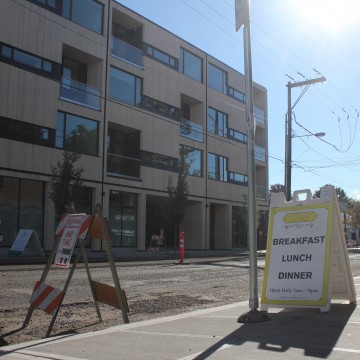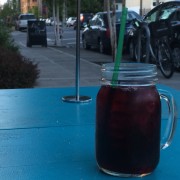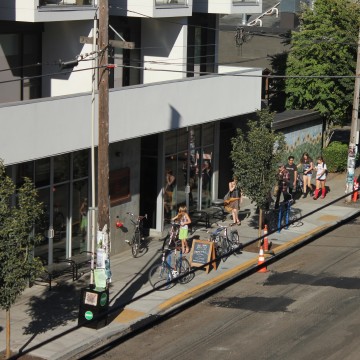Does Good Food Lead to Gentrification?
Friday, August 29, 2014

The newest location of Lardo on Williams Avenue. Photo: Emily Leidel
On Thursday, the development of a new health food store was announced for a highly contentious corner in Northeast Portland that been the center of a boisterous public debate on gentrification in the area.
Natural Grocers of Colorado announced they would build a new store on the corner of Northeast Alberta Street and Martin Luther King Jr. Boulevard.
Seven months earlier Trader Joe’s backed out of a proposal to build on the same spot; they retreated after groups such as the NAACP and the Portland African American Leadership Forum accused the city of subsidizing gentrification on publicly owned land.
While the dust settles on the deal struck with the community, high quality food continues to be a vanguard force in what some consider urban redevelopment and others consider gentrification.
Food and Development
Portland’s booming restaurant scene, storied in New York Times articles and foodie TV shows, is increasingly intertwined with urban redevelopment.
That can be a double-edged sword when explosive growth hits a neighborhood.
Teressa Raiford’s family has owned property in Northeast Portland for three generations. She said her family has seen the proliferation of restaurants and the new middle class and mostly white residents that come with them in the neighborhood over the last decade.
“Restaurants and the liquor licenses come in first,” Raiford said. “I don’t think it’s in the interest of the people who were in the community with children.”
A recent survey of new residents in cities such as Boston, Austin and San Francisco done by the design firm Sasaki found that good food was a driving force in what draws people to live in urban communities.
Look down Portland’s North Williams Avenue and Southeast Division Street and you’ll see new eateries advancing in lock step with new mid-rise housing developments.
On North Williams Avenue some 19 eateries line a nine-block stretch that was once mostly vacant lots. The area sits in the heart of what once was Portland’s African American community.
Jen Lewis opened Lincoln, a high-end restaurant on Williams Avenue in 2008.
“We didn’t know what to expect when we opened,” Lewis said. “We were one of the first to anchor the neighborhood.”
At the time, Lewis knew a raft of new developments was planned for the area, but the recession quickly shelved most projects.

Southeast Division Street. Photo: Emily Leidel
Restaurants such as Hop Works, Tasty N’ Sons, Lardo and others have joined Lincoln on the avenue.
“Restaurants are what draw people [to an area],” Lewis said. “People come and then they walk around and explore the neighborhood.”
That kind of critical mass of visitors is what fuels more development.
Sidebar: Study Finds Largely Black Neighborhoods Less Likely to Gentrify
“Restaurants like to cluster so the area becomes known as a destination so it just feeds on itself,” said Charles Rynerson of Portland State University’s Population Research Center.
Rynerson said there have been lots of studies on the relationship between retail development and gentrification, but nothing on specifically linking restaurants and gentrification. Nonetheless, he said, “I have no doubts that [the link] exists.”
Developers build with restaurants in mind
What’s clear is that there is a link between restaurants and apartment building developments in Portland.
Debbie Sung is marketing coordinator for LRS Architects. The firm worked on four projects on North Williams Avenue; a New Seasons Market grocery store and three multistory apartment buildings with ground-floor retail.
Sung said developers are increasingly building urban housing with restaurants in mind.
“We have clients who’ve stated that the best way to ensure an apartment building rents well is to have a great restaurant on the ground floor,” Sung said. “Having a trendy, destination restaurant move in has been added to the design priorities list, alongside materials and finishes.
“I don’t think architects will like to agree with this, but we are hearing it.”
That can mean restaurants have more influence with developers. “[It’s] to the point that the potential restaurant has a lot more power to negotiate the space now than just five years ago,” Sung said.
Southeast Portland: Ground Zero

Williams Avenue. Photo: Emily Leidel
Pok-Pok, the groundbreaking Thai restaurant, has been joined by American Local, Mi Mero Mole and Bollywood Theater and others in just the last two years.
Jenny Nickolaus opened American Local in January with her boyfriend. Since then, Nickolaus said, three new restaurants have opened on the street.
“This is the neighborhood that Pok Pok built,” said Nickolaus, who is thrilled about the exciting food scene burgeoning on the street. Nickolaus said when she lived in Brooklyn, N.Y., she saw a restaurant in the East Williamsburg neighborhood pioneer new development in much the same way.
A wide range of impacts
While that’s widened food choices, not everyone thinks recent developments have improved their neighborhoods.
In 2012, the Southeast Division area was a flashpoint for opposition to apartments building designed without onsite parking. Neighbors worried that new residents and business patrons were clogging streets and taking up on-street parking. The city changed minimum parking requirements the following year.
"Some people like all the restaurants and bars on Division,” said neighborhood resident Allen Field. "Others will complain that they can't afford to eat at the restaurants on Division.”
That problem is more acutely felt along North Williams Avenues, where economic development is entangled with Oregon’s history of racial discrimination.
The issue intensifies as each turn of the business cycle brings a new round of investment to the area.

Southeast Division Street. Photo: Emily Leidel
But it’s impacted an area once dominated by families.
“They closed down Humboldt School and Harriet Tubman,” said Raiford of two public schools adjacent to Williams Avenue that have closed in the last two years. “Why are your bringing in restaurant bars and closing schools.”
Rynerson said families and people in poverty are being shifted from urban neighborhoods to the suburbs, often not by choice.
An activist in the black community, Raiford said gentrification in Northeast Portland has been divisive. That said, Raiford and others don’t see development or restaurants as inherently bad.
Her uncle owns a lot at 3952 Northeast Martin Luther King Jr. Boulevard. Raiford hopes to turn the 114-year-old building on the property into a local black heritage center, ringed by a food cart pod specializing in soul food.
For her, investment in the area is a net positive if there are benefits for existing residents. She said that the city of Portland had tools and resources available that could be usede, but too often there is not enough connection between residents and government.
“Leadership in the community is what’s needed,” Raiford said. “The leadership needs to take a stand and community members need to be invited to the table.”
Related Articles
- See Oregon’s History of Discrimination
- Court Case Argues Portland Parking Tickets Are Not Valid
- Portland City Council White by Law?




 Delivered Free Every
Delivered Free Every
Follow us on Pinterest Google + Facebook Twitter See It Read It